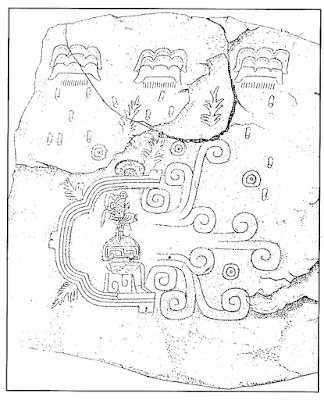Saturday, August 15, 2015
WIND SYMBOLS IN ROCK ART OF CHACO CANYON:
Chaco Canyon, New Mexico.
Photograph Peter Faris, August 1984.
Double Scroll from Fajada Butte, Chaco
Canyon, New Mexico. Sofaer, Anna P.,
and Rolf M. Sinclair, 2008, Astronomical
Markings at Three Sites on Fajada Butte,
pp. 669 – 692, in Foundations of New
World Cultural Astronomy.
On Saturday, December 6, 2014, I posted a column entitled
Speech Scrolls in Rock Art? In this posting I drew a parallel between the
Mesoamerican symbol for a speech scroll with a rock art panel in Chaco Canyon.
This is really only part of the possibility however. In the same way as I
postulated the possibility of Mesoamerican speech scrolls in the rock art of
North America, I would now like to point out the similarity to Mesoamerican wind
symbols.
“Cloud scroll with
raindrops (detail of
recently discovered monument at
Chalcatzingo).” Taube, Fig. 75, p. 107.
The fact is that Mesoamerican peoples saw a similarity
between the breath coming out of the mouth in speech, and wind, and they
symbolically related these by using similar signs to indicate wind and breath,
and the symbols in Chaco Canyon thus can be viewed as possible speech symbols,
or possibly as the wind. Just look at the remarkable similarities between the
symbols in Chaco Canyon and the examples of wind symbols from Karl Taube's
chapter "The Breath of Life, in The Road to Aztlan," by Fields and
Zamudio-Taylor.
In this instance, as in previous examples of such
similarities I point out that we have long known of and accepted influences
from the Mesoamerican civilizations in early peoples of the American southwest.
This influence is assumed to have been asserted by pochteca. "Pochteca
(singular pochtecatl) were professional, long-distance traveling merchants in
the Aztec Empire. They were a small, but important class as they not only
facilitated commerce, but also communicated vital information across the empire
and beyond its borders." (Wikipedia)
Evidence of this is seen in Mesoamerican goods and products
in southwestern America as well as in the supposed Mesoamerican ideas found
among cultures here. Images interpreted as Mesoamerican deities such as
Quetzalcoatl and Tlaloc have long been accepted on southwestern American rock
art, and physical objects such as macaws and cast metal bells have been found
in archaeological excavations in the American southwest, including Chaco
Canyon.
The Aztec wind got was a duck-billed deity named Ehecatl. It
is perhaps no coincidence that Pawik kachina of the Hopi is the duck kachina
who is prayed to for wind and rain. Additionally, the kachinas travel to and from
their homes in the San Francisco peaks in the form of ducks.
Early rock art researcher Campbell Grant went so far as to
associate the duck-headed figures found in ancestral Puebloan rock art with
Ehecatl and Pawik. While I am not in a position to refute that, I am not
willing to go that far in this discussion. I do, however, find an intriguing similarity
between the figures from Chaco Canyon and the wind symbols of Mesoamerican cultures,
and believe that a case might be made for such an influence.
REFERENCE:
Pasztory, Esther
1998 Pre-Columbian Art, Cambridge University
Press, Cambridge.
Sofaer, Anna P., and Rolf M. Sinclair
2008 Astronomical Markings at Three Sites on
Fajada Butte, pp. 669 – 692, in Foundations
of New World Cultural Astronomy, edited by Anthony Aveni, University Press
of Colorado, Boulder.
Taube, Karl,
2001 The Breath of Life: the Symbolism of Wind in
Mesoamerica and the American Southwest, pages 102 – 123, The Road To Aztlan: Art From A Mythic Homeland, edited by Fields,
Virginia M., and Victor Zamudio-Taylor, Los Angeles County Museum of Art, Los
Angeles.
Wikipedia
Labels:
Ancestral puebloan,
Aztec,
Chaco Canyon,
duck,
Mesoamerican,
Pawik kachina,
petroglyph,
rock art,
wind symbol
Subscribe to:
Post Comments (Atom)










No comments:
Post a Comment